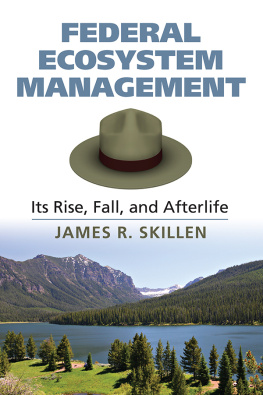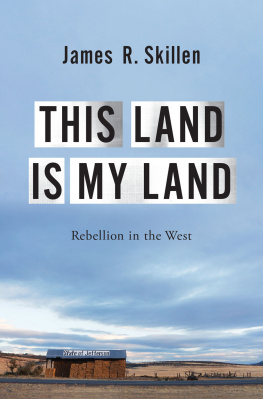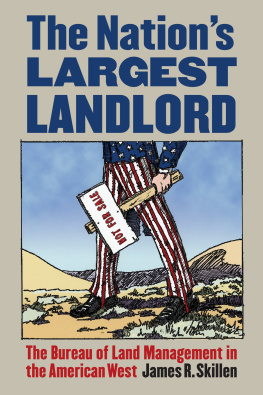Federal Ecosystem Management
Federal Ecosystem Management
Its Rise, Fall, and Afterlife
James R. Skillen
| University Press of Kansas |
2015 by the University Press of Kansas
All rights reserved
Published by the University Press of Kansas (Lawrence, Kansas 66045 ), which was organized by the Kansas Board of Regents and is operated and funded by Emporia State University, Fort Hays State University, Kansas State University, Pittsburg State University, the University of Kansas, and Wichita State University
Library of Congress Cataloging-in-Publication Data
Skillen, James.
Federal ecosystem management : its rise, fall, and afterlife / James R. Skillen.
pages cm
Includes bibliographical references and index.
ISBN 978-0-7006-2127-9 (cloth : alk. paper)
ISBN 978-0-7006-2164-4 (ebook)
. Ecosystem managementWest (U.S.) . Ecosystem management
Yellowstone National Park Region. I. Title.
QH76.5.w34s55 2015
333.720978dc23
2015020376
British Library Cataloguing-in-Publication Data is available.
Printed in the United States of America
10987654321
The paper used in this publication is recycled and contains percent postconsumer waste. It is acid free and meets the minimum requirements of the American National Standard for Permanence of Paper for Printed Library Materials Z.- 1992 .
For Sam & Ben
Contents
Acknowledgments
This project started as an essay on the integration of scientific and political authority in federal ecosystem management. As the project expanded, so did the list of people that deserve my gratitude. Thank you first to my family: Beth, Sam, and Ben. They do not necessarily share my interest in appropriations riders, judicial rulings, or the vast array of federal acronyms, but they certainly share my interest in public lands throughout the American West. Thank you for all of the time we have spent exploring.
This project took shape with assistance from numerous scholars, public servants, and research assistants. I am particularly grateful to John Freemuth, Bill Rowley, Paul Culhane, and John Nagle for long conversations and for reviewing portions of this manuscript. I am also grateful to many, many current and retired employees from the Forest Service and the BLM, including folks at the Forest Services Pacific Northwest Research Station and the Public Lands Foundation. For the NWFP chapter, thank you especially to Elaine Zielinski, and for the ICBEMP chapter, thank you especially to Geoff Middaugh. I am grateful for general research assistance from Rachel Stehouwer, Bethany Van Kooten, and Seth Kenbeek, and for general editing assistance from Katie Sauer. Finally, I am grateful to my colleague Melissa Sexton for her extensive editorial comments. All of these people contributed to the project, but none are responsible for any errors or misinterpretations.
This project was made possible by financial support from a number of sources. I am grateful to Calvin College for several research fellowships that provided time for research and writing and to the Mellema Program in Western American Studies for funding travel to various archives. I am also grateful to the Oregon Extension for generous support that provided time for me to finish the manuscript.
Finally, thank you to my children, Sam (11) and Ben (9), who volunteered to make pancakes for dinner one night during the late stages of writing so that I could stay hunched over my keyboard. You may not want to read the whole book, but please at least read the dedication.
Abbreviations
| ACS | Aquatic Conservation Strategy |
| AMA | adaptive management area |
| APHIS | USDA Animal and Plant Health Inspection Service |
| BLM | Bureau of Land Management |
| CCA | Candidate Conservation Agreement |
| CEQ | Council on Environmental Quality |
| DSEIS | Draft SEIS |
| DFWP | Department of Fish, Wildlife, and Parks |
| EIS | environmental impact statement |
| EPA | Environmental Protection Agency |
| ESA | Endangered Species Act of 1973 |
| ESC | executive steering committee |
| FEMAT | Forest Ecosystem Management Assessment Team |
| FLPMA | Federal Land Policy and Management Act of 1976 |
| FSEIS | Final EIS |
| FWS | US Fish and Wildlife Service |
| GAO | Government Accountability Office |
| GYC | Greater Yellowstone Coalition |
| GYCC | Greater Yellowstone Coordinating Committee |
| GYE | Greater Yellowstone Ecosystem |
| HCA | Habitat Conservation Area |
| HCP | habitat conservation plan |
| IBMP | Interagency Bison Management Plan |
| ICBEMP | Interior Columbia Basin Ecosystem Management Project |
| ICRB | Interior Columbia River Basin |
| IGBST | Interagency Grizzly Bear Study Team |
| INFISH | Inland Native Fish Strategy |
| LCAT | Labor and Community Assistance Team |
| MOU | Memorandum of Understanding |
| MUSY | multiple use and sustained yield |
| NAS | National Academy of Sciences |
| NBS | National Biological Survey |
| NEPA | National Environmental Policy Act of 1969 |
| NFMA | National Forest Management Act of 1976 |
| NMFS | National Marine Fisheries Service |
| NPS | National Park Service |
| NWFP | Northwest Forest Plan |
| PACFISH | Interim Strategies for Managing Anadromous Fish-Producing Watersheds |
| PARC | Division of Predator and Rodent Control (US Fish and Wildlife Service) |
| RCA | riparian conservation area |
| RIEC | Regional Interagency Executive Committee |
| REO | Regional Ecosystem Office |
| ROD | Record of Decision |
| S&M | Survey and Manage |
| SBO | supplemental biological opinion |
| SDEIS | Supplemental Draft EIS |
| SIT | Science Integration Team |
| SEIS | Supplemental EIS |
| USGS | US Geological Survey |
Introduction
It has become apparent that we are witnessing one of the most interesting periods in natural resource management since the heady days of Progressivism.
John Freemuth, The Emergence of Ecosystem Management: Reinterpreting the Gospel? (1996)
Some have suggested that these differences amount to no less than a radical revision of professional perspectives, values, and management practicesin other words, a paradigm shift.
Hanna Cortner and Margaret Moote, The Politics of Ecosystem Management (1999)
Is a new era dawning on the western public domain?
Robert Keiter, Keeping Faith with Nature (2003)
Background
In the 1990s, scholars, policymakers, land managers, and many others were talking about a new paradigm for federal lands and resources: ecosystem management. Advocates of this new approach promised that it would yield a host of benefits: integrating federal land and resource management across jurisdictional boundaries; protecting biodiversity













